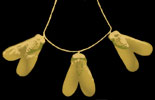New Kingdom
Towards the end of the Second Intermediate Period, the native Egyptian ruling family based in Thebes were locked in a struggle with the Hyksos to regain all of Egypt. This turbulent period set the scene for the powerful queens of the New Kingdom to assert their position.
Tetisheri
Tetisheri was the mother of Seqenenre Tao, and may have acted as his regent when his father (Senakhtenre Ahmose) died. She seems to have been valued as a wise counsellor by three generations of kings and was given many honours and titles, including King’s Great Wife. She may also have been the first queen to wear the vulture headdress of Nekhbet.

Ahhotep
Ahhotep I was the wife of Seqenenre Taa and the mother of Ahmose. When her husband was killed in battle with the Hyksos he was succeeded by Kamose, possibly a warrior of noble birth. When he too fell her son, Ahmose, became king at the age of ten. Ahhotep acted as his regent and maintained an uneasy truce with the Hyksos for ten years until Ahmose was old enough to rule alone.
When he succeeded in expelling the Hyksos from Egypt he led an army into Nubia to regain lost territories. While he was gone there was an uprising which Ahhotep quashed. She held the title “Mistress of the two lands” (echoing one of the five king’s names) and was the first woman to hold the title “God’s Wife”. Texts from her burial make it clear that she was an active regent whom her son credited with protecting his kingdom.

Ahmose Nefertari
Ahmose Nefertari was the wife of Ahmose I and the mother of Amenhotep I. She too held the title God’s Wife, but may also have been the Second Prophet of Amun. Her husband and son endowed her with vast swathes of property and even recorded asking her advice before establishing a monument for his grandmother Tetisheri. When he died she acted as regent for Amenhotep I for around seven years, and may also have been instrumental in the accession of Tuthmosis I. After her death she was deified.

Hatshepsut
Hatshepsut was the daughter of Tuthmosis I and the wife of Tuthmosis II. When her husband died she acted as regent for her nephew Tuthmosis III. What started out as a fairly conventional regency developed into a long period of co-rule with a man who was to grow into one of the most famous warrior kings of Egypt.
Much has been written about Hatshepsut, good and bad, but there is no doubt that she was a powerful and successful pharaoh of Egypt.

Nefertiti
Nefertiti is one of the most famous women of the ancient world. She and her husband, Akhenaten, oversaw a revolutionary change in the religion of Egypt which was not to survive long after their demise. She was depicted smiting the enemies of Egypt, and like Hatshepsut she used the Atef crown (normally only worn by the king).
We do not know for sure whether she was co-regent with her husband or whether she ruled after his death. In fact, we do not even know when she died. Some commentators have claimed that she ruled as Smenkhare, but this now seems unlikely. Ruler or not, she certainly had a highly prominent position suggestive of a significant degree of power.

Tausret
Tausret was the wife of Seti II. When he died she ruled as regent for his son (her step-son) Siptah. When Siptah died after around seven years, she became sole ruler for between one and a half and four years. It was previously suggested that Tausret was only a figurehead and the real power lay with the Chancellor, Bay.
However, we now know that Bay was executed during the fifth year of the reign of Siptah. A statue which is highly reminiscent of the statue of Ankhnesenpepi II and Pepi II depicted Tausret with Siptah sitting on her knee. While the young king has not been damaged, her image has been hacked to pieces. This hints at the turmoil at the end of her reign. Her tomb was usurped by Ramessess III and used for the burial of her successor Setnakht and her name was omitted from the kings list compiled at that time.

Bibliography
- Capel, Anne K and Markoe Glenn E. (Editors) (1996) Mistress of the House, Misteress of Heaven
- Dodson, Aidan and Hilton, Dyan (2004) The Complete Royal Families of Ancient Egypt
- Graves-Brown, Carolyn (2010) Dancing for Hathor
- Hawass, Zahi (1995) Silent Images: Women in ancient Egypt
- Robins, Gae (1993) Women in Ancient Egypt
- Shaw, Ian (Editor) (2000) The Oxford History of Ancient Egypt
- Tyldesley, Joyce (2006) Chronicle of the Queens of Egypt
- Ziegler, Christine (Editor) (2008) Queens of Egypt: From Hetepheres to Cleopatra
Copyright J Hill 2018